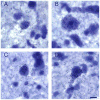Changes in prodynorphin gene expression and neuronal morphology in the hypothalamus of postmenopausal women
- PMID: 19094085
- PMCID: PMC2893873
- DOI: 10.1111/j.1365-2826.2008.01796.x
Changes in prodynorphin gene expression and neuronal morphology in the hypothalamus of postmenopausal women
Abstract
Human menopause is characterised by ovarian failure, gonadotrophin hypersecretion and hypertrophy of neurones expressing neurokinin B (NKB), kisspeptin (KiSS)-1 and oestrogen receptor (ER) alpha gene transcripts within the hypothalamic infundibular (arcuate) nucleus. In the arcuate nucleus of experimental animals, dynorphin, an opioid peptide, is colocalised with NKB, kisspeptin, ER alpha and progesterone receptors. Moreover, ovariectomy decreases the expression of prodynorphin gene transcripts in the arcuate nucleus of the ewe. Therefore, we hypothesised that the hypertrophied neurones in the infundibular nucleus of postmenopausal women would express prodynorphin mRNA and that menopause would be accompanied by changes in prodynorphin gene transcripts. In the present study, in situ hybridisation was performed on hypothalamic sections from premenopausal and postmenopausal women using a radiolabelled cDNA probe targeted to prodynorphin mRNA. Autoradiography and computer-assisted microscopy were used to map and count labelled neurones, measure neurone size and compare prodynorphin gene expression between premenopausal and postmenopausal groups. Neurones expressing dynorphin mRNA in the infundibular nucleus of the postmenopausal women were larger and exhibited hypertrophied morphological features. Moreover, there were fewer neurones labelled with the prodynorphin probe in the infundibular nucleus of the postmenopausal group compared to the premenopausal group. The number of dynorphin mRNA-expressing neurones was also reduced in the medial preoptic/anterior hypothalamic area of postmenopausal women without changes in cell size. No differences in cell number or size of dynorphin mRNA-expressing neurones were observed in any other hypothalamic region. Previous studies using animal models provide strong evidence that the changes in prodynorphin neuronal size and gene expression in postmenopausal women are secondary to the ovarian failure of menopause. Given the inhibitory effect of dynorphin on the reproductive axis, decreased dynorphin gene expression could play a role in the elevation in luteinising hormone secretion that occurs in postmenopausal women.
Figures



Similar articles
-
Hypertrophy and increased kisspeptin gene expression in the hypothalamic infundibular nucleus of postmenopausal women and ovariectomized monkeys.J Clin Endocrinol Metab. 2007 Jul;92(7):2744-50. doi: 10.1210/jc.2007-0553. Epub 2007 May 8. J Clin Endocrinol Metab. 2007. PMID: 17488799
-
Hypertrophy and increased gene expression of neurons containing neurokinin-B and substance-P messenger ribonucleic acids in the hypothalami of postmenopausal women.Endocrinology. 1991 May;128(5):2239-47. doi: 10.1210/endo-128-5-2239. Endocrinology. 1991. PMID: 1708331
-
Coexpression of dynorphin and neurokinin B immunoreactivity in the rat hypothalamus: Morphologic evidence of interrelated function within the arcuate nucleus.J Comp Neurol. 2006 Oct 10;498(5):712-26. doi: 10.1002/cne.21086. J Comp Neurol. 2006. PMID: 16917850
-
Modulation of body temperature and LH secretion by hypothalamic KNDy (kisspeptin, neurokinin B and dynorphin) neurons: a novel hypothesis on the mechanism of hot flushes.Front Neuroendocrinol. 2013 Aug;34(3):211-27. doi: 10.1016/j.yfrne.2013.07.003. Epub 2013 Jul 17. Front Neuroendocrinol. 2013. PMID: 23872331 Free PMC article. Review.
-
Hormonal influences on morphology and neuropeptide gene expression in the infundibular nucleus of postmenopausal women.Prog Brain Res. 1992;93:221-35; discussion 235-6. doi: 10.1016/s0079-6123(08)64574-4. Prog Brain Res. 1992. PMID: 1336203 Review.
Cited by
-
Resistance training reduced luteinising hormone levels in postmenopausal women in a substudy of a randomised controlled clinical trial: A clue to how resistance training reduced vasomotor symptoms.PLoS One. 2022 May 26;17(5):e0267613. doi: 10.1371/journal.pone.0267613. eCollection 2022. PLoS One. 2022. PMID: 35617333 Free PMC article. Clinical Trial.
-
The role and potential sites of action of thyroid hormone in timing the onset of puberty in male primates.Brain Res. 2010 Dec 10;1364:175-85. doi: 10.1016/j.brainres.2010.09.082. Epub 2010 Sep 29. Brain Res. 2010. PMID: 20883669 Free PMC article. Review.
-
Estradiol alters body temperature regulation in the female mouse.Temperature (Austin). 2017 Nov 30;5(1):56-69. doi: 10.1080/23328940.2017.1384090. eCollection 2018. Temperature (Austin). 2017. PMID: 29687044 Free PMC article.
-
Effects of menopause on temperature regulation.Temperature (Austin). 2025 Apr 23;12(2):92-132. doi: 10.1080/23328940.2025.2484499. eCollection 2025. Temperature (Austin). 2025. PMID: 40330614 Free PMC article. Review.
-
Arcuate kisspeptin/neurokinin B/dynorphin (KNDy) neurons mediate the estrogen suppression of gonadotropin secretion and body weight.Endocrinology. 2012 Jun;153(6):2800-12. doi: 10.1210/en.2012-1045. Epub 2012 Apr 16. Endocrinology. 2012. PMID: 22508514 Free PMC article.
References
-
- Block E. Quantitative morphological investigations of the follicular system in women; variations at different ages. Acta Anat. 1952;14:108–123. - PubMed
-
- Hansen KR, Knowlton NS, Thyer AC, Charleston JS, Soules MR, Klein NA. A new model of reproductive aging: the decline in ovarian non-growing follicle number from birth to menopause. Hum Reprod. 2008;23:699–708. - PubMed
-
- Rance NE, McMullen NT, Smialek JE, Price DL, Young WS., III Postmenopausal hypertrophy of neurons expressing the estrogen receptor gene in the human hypothalamus. J Clin Endocrinol Metab. 1990;71:79–85. - PubMed
-
- Rance NE, Young WS., III Hypertrophy and increased gene expression of neurons containing neurokinin-B and substance-P messenger ribonucleic acids in the hypothalami of postmenopausal women. Endocrinology. 1991;128:2239–2247. - PubMed
Publication types
MeSH terms
Substances
Grants and funding
LinkOut - more resources
Full Text Sources
Other Literature Sources

